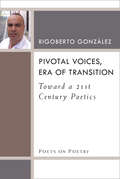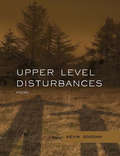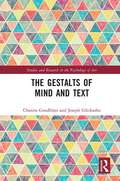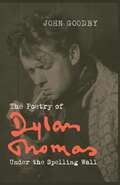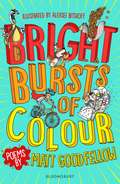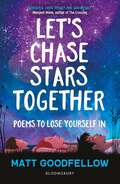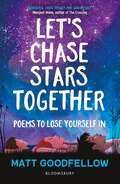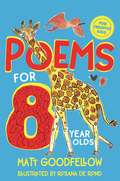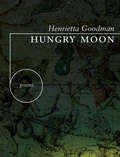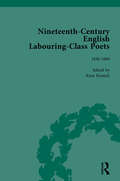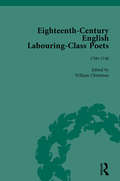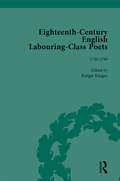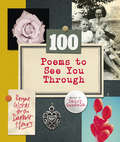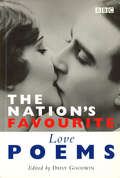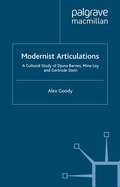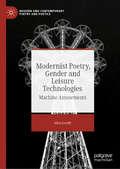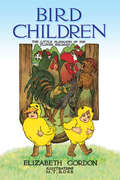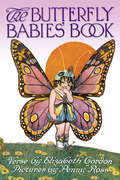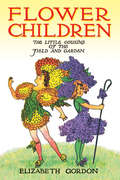- Table View
- List View
Pivotal Voices, Era of Transition: Toward a 21st Century Poetics (Poets On Poetry)
by Rigoberto GonzalezPivotal Voices, Era of Transition gathers Rigoberto González’s most important essays and book reviews, many of which consider the work of emerging poets whose identities and political positions are transforming what readers expect from contemporary poetry. A number of these voices represent intersectional communities, such as queer writers of color like Natalie Díaz, Danez Smith, Ocean Vuong, and Eduardo C. Corral, and many writers, such as Carmen Giménez Smith and David Tomás Martínez, have deep connections to their Latino communities. Collectively, these writers are enriching American poetry to reflect a more diverse, panoramic, and socially conscious literary landscape. Also featured are essays on the poets’ literary ancestors—including Juan Felipe Herrera, Alurista, and Francisco X. Alarcón—and speeches that address the need to leverage poetry as agency. This book fills a glaring gap in existing poetry scholarship by focusing exclusively on writers of color, and particularly on Latino poetry. González makes important observations about the relevance, urgency, and exquisite craft of the work coming from writers who represent marginalized communities. His insightful connections between the Latino, African American, Asian American, and Native American literatures persuasively position them as a collective movement critiquing, challenging, and reorienting the direction of American poetry with their nuanced and politicized verse. González’s inclusive vision covers a wide landscape of writers, opening literary doors for sexual and ethnic minorities.
Upper Level Disturbances (Mountain West Poetry Series)
by Kevin GoodanMountain West Poetry Series Published by the Center for Literary Publishing at Colorado State University
The Gestalts of Mind and Text (Studies and Research in the Psychology of Art)
by Chanita Goodblatt Joseph GlicksohnThe Gestalts of Mind and Text bridges literary studies and cognitive psychology to provide a unique contribution to the field of Cognitive Literary Studies. The book presents an investigation of metaphor in poetic texts, adopting and developing empirical methods used by Gestalt Psychology, while integrating concepts informed by Gestalt Psychology. The title indicates an intellectual tradition, to be termed the Gestalt of the Mind, that begins with the Würzburg School of Psychology and its subsequent development into Gestalt Psychology, which provides a rich heritage for the field of Cognitive Literary Studies. The title further indicates an intellectual and creative tradition, to be termed the Gestalt of the Text, applied to various literary schools (Medieval, Early Modern, Modernist). Finally, the Gestalt-Interaction Theory of Metaphor delineates the potentialities for different types of readings of poetic metaphor. This book further makes three significant contributions: the first is the focus on the empirical investigation of metaphor in poetic texts; the second is the integration of the aspects of problem-solving, bidirectionality of metaphor, embodied cognition and the grotesque, in analyzing poetic texts and verbal protocols; and the third is the focus on various literary traditions, spanning languages and periods. The goal of this book is to present an interdisciplinary study of the Gestalts of Mind and Text. This will be of interest to a varied audience, including cognitive psychologists, literary scholars, researchers in aesthetics, scholars of metaphor and those with an interest in intellectual history.
The Gestalts of Mind and Text (Studies and Research in the Psychology of Art)
by Chanita Goodblatt Joseph GlicksohnThe Gestalts of Mind and Text bridges literary studies and cognitive psychology to provide a unique contribution to the field of Cognitive Literary Studies. The book presents an investigation of metaphor in poetic texts, adopting and developing empirical methods used by Gestalt Psychology, while integrating concepts informed by Gestalt Psychology. The title indicates an intellectual tradition, to be termed the Gestalt of the Mind, that begins with the Würzburg School of Psychology and its subsequent development into Gestalt Psychology, which provides a rich heritage for the field of Cognitive Literary Studies. The title further indicates an intellectual and creative tradition, to be termed the Gestalt of the Text, applied to various literary schools (Medieval, Early Modern, Modernist). Finally, the Gestalt-Interaction Theory of Metaphor delineates the potentialities for different types of readings of poetic metaphor. This book further makes three significant contributions: the first is the focus on the empirical investigation of metaphor in poetic texts; the second is the integration of the aspects of problem-solving, bidirectionality of metaphor, embodied cognition and the grotesque, in analyzing poetic texts and verbal protocols; and the third is the focus on various literary traditions, spanning languages and periods. The goal of this book is to present an interdisciplinary study of the Gestalts of Mind and Text. This will be of interest to a varied audience, including cognitive psychologists, literary scholars, researchers in aesthetics, scholars of metaphor and those with an interest in intellectual history.
The Poetry of Dylan Thomas: Under the Spelling Wall (Liverpool English Texts and Studies #60)
by John GoodbyPublished in anticipation of the centenary of the poet’s birth, The Poetry of Dylan Thomas is the first study of the poet to show how his work may be read in terms of contemporary critical concerns, using theories of modernism, the body, gender, the carnivalesque, language, hybridity and the pastoral in order to view it in an original light. Moreover, in presenting a Dylan Thomas who has real significance for twenty-first century readers, it shows that such a reappraisal also requires us to re-think some of the ways in which all post-Waste Land British poetry has been read in the last few decades.
Bright Bursts of Colour
by Matt Goodfellow'Matt Goodfellow is a fresh voice on the children's poetry scene.' (Pie Corbett)What if cats had flavoured fur or if you swallowed the sun? What if you were a special kind of badger or if you found a map to the stars? And what if your home was split during the week: one half at Mum's, the other half at Dad's?Packed with brilliant poems that explore a whole range of themes from the downright silly to the sensitive, this collection will delight, enthuse and resonate with children and adults alike!
Bright Bursts of Colour
by Matt Goodfellow'Matt Goodfellow is a fresh voice on the children's poetry scene.' (Pie Corbett)What if cats had flavoured fur or if you swallowed the sun? What if you were a special kind of badger or if you found a map to the stars? And what if your home was split during the week: one half at Mum's, the other half at Dad's?Packed with brilliant poems that explore a whole range of themes from the downright silly to the sensitive, this collection will delight, enthuse and resonate with children and adults alike!
Let's Chase Stars Together: Poems to lose yourself in, perfect for 10+
by Matt GoodfellowA standout new collection of contemporary poems from prize-winning poet Matt Goodfellow, author of Bright Bursts of Colour.Perfectly reflecting the thoughts, feelings and imaginings of young people, these beautifully crafted poems are poignant, playful, heartfelt and hopeful.From friendship, family and separation to school experiences and fitting in, this moving collection touches on the relatable aspects of growing up. It delicately balances emotion with light relief and humour, and is sure to captivate any young person aged 10 and above.'Goodfellow has the knack for choosing all the right words.' The Guardian'Matt Goodfellow is a poet whose works are ideal for children.' Express
Let's Chase Stars Together: Poems to lose yourself in, perfect for 10+
by Matt GoodfellowA standout new collection of contemporary poems from prize-winning poet Matt Goodfellow, author of Bright Bursts of Colour.Perfectly reflecting the thoughts, feelings and imaginings of young people, these beautifully crafted poems are poignant, playful, heartfelt and hopeful.From friendship, family and separation to school experiences and fitting in, this moving collection touches on the relatable aspects of growing up. It delicately balances emotion with light relief and humour, and is sure to captivate any young person aged 10 and above.'Goodfellow has the knack for choosing all the right words.' The Guardian'Matt Goodfellow is a poet whose works are ideal for children.' Express
Poems for 8 Year Olds
by Matt GoodfellowA brilliant collection of poems for 8 year olds packed with poems about friends, space, pets, nature, magic, family, school, adventure, compiled by Matt Goodfellow.Includes classic and contemporary poems by , A.F. Harrold, Matt Goodfellow, Charles Causley, Laura Mucha, Jan Dean, Kate Wakeling, James Carter, Roger Stevens, Brian Moses and many more.
Hungry Moon (Mountain West Poetry Series)
by Henrietta GoodmanWith intimacy and depth of insight, Henrietta Goodman’s Hungry Moon suggests paradox as the most basic mode of knowing ourselves and the world. We need hunger, the poems argue, but also satisfaction. We need pain to know joy, joy to know pain. We need to protect ourselves, but also to take risks. Though the poems are drawn from personal experience, Goodman shares the conviction of such poets as Anne Sexton and Louise Glück that when the poet writes of the self, the self cannot be exempt from culpability. Goodman’s speaker ranges through time and locale—from exploring the experience of flying in a small plane with her lover/pilot over the landscape of the American West to addressing the grief and retrospective self-scrutiny that arise from a friend’s death. Like the work of Mark Doty and Tony Hoagland, Goodman’s poems embrace concrete particularity, entangled as it is with imperfection and loss: “the Quik Stop’s fridge full of sandwiches and small bottles of livestock vaccines,” “the black, hammer-struck moon of your thumb,” “the empty water tower, one rusted panel kicked in like a door.”
Nineteenth-Century English Labouring-Class Poets Vol 2
by John GoodridgeOver 100 poets of labouring class origin were published in Britain in the 18th and 19th centuries. Some were hugely popular and important in their day but few are available today. This is a collection of some of those poems from the 19th century.
Nineteenth-Century English Labouring-Class Poets Vol 2
by John GoodridgeOver 100 poets of labouring class origin were published in Britain in the 18th and 19th centuries. Some were hugely popular and important in their day but few are available today. This is a collection of some of those poems from the 19th century.
Eighteenth-Century English Labouring-Class Poets, vol 1
by John Goodridge Simon Kövesi David Fairer Tim Burke William ChristmasPoets of labouring class origin were published in Britain in the 18th and 19th centuries. Some were popular and important in their day but few are available today. This is a collection of some of those poems from the 18th century.
Eighteenth-Century English Labouring-Class Poets, vol 1
by John Goodridge Simon Kövesi David Fairer Tim Burke William ChristmasPoets of labouring class origin were published in Britain in the 18th and 19th centuries. Some were popular and important in their day but few are available today. This is a collection of some of those poems from the 18th century.
Eighteenth-Century English Labouring-Class Poets, vol 2
by John Goodridge Simon Kövesi David Fairer Tim Burke William ChristmasPoets of labouring class origin were published in Britain in the 18th and 19th centuries. Some were popular and important in their day but few are available today. This is a collection of some of those poems from the 18th century.
Eighteenth-Century English Labouring-Class Poets, vol 2
by John Goodridge Simon Kövesi David Fairer Tim Burke William ChristmasPoets of labouring class origin were published in Britain in the 18th and 19th centuries. Some were popular and important in their day but few are available today. This is a collection of some of those poems from the 18th century.
100 Poems To See You Through
by Daisy GoodwinWhen times are tough - whether because of illness, bereavement or receiving bad news - it can be hard to find the right words. Help comes in the form of this beautifully packaged gift book, comprising 100 life-affirming poems handpicked by an expert on poetry. Grouping the poems by theme - from 'Hearing Bad News' to 'How To Carry On' - this gem of a book features contributions from classical poets such as John Keats, Emily Brontë, W.H. Auden and Christina Rossetti alongside lines from more contemporary poets such as Philip Larkin, Elizabeth Jennings, Raymond Carver, Carol Ann Duffy and Wendy Cope. It adds up to a wonderful pick-me-up - a self-administered drug guaranteed to make a dark day brighter and act as a great lyrical crutch.
The Nation's Favourite: Love Poems
by Daisy GoodwinFrom the first flush of love, through courtship and vows of eternal fidelity, to serving the writs and drowning your sorrows, 'The Nation's Favourite Love Poems' will meet all your romantic requirements. In this selection of 100 popular poems, poets of every age consider that most universal of themes: love. As well as traditional lovers' favourites such as Elizabeth Barrett Browning's 'How do I love thee?' and Shakespeare's 'Shall I compare thee to a summer's day?' there are contemporary voices such as Adrian Mitchell, Wendy Cope and John Fuller, whose erudite yet salacious 'Valentine' would melt the most fridgid heart. There are even poems for those more melancholic moments, Hardy's haunting 'After a Journey', for example, and Larkin's poignant 'Love Songs in Age'. So, wherever you are in the tunnel of love, dip into this book of poetry and you will be reassured to discover that at one time or another a poet has been there before you.
Modernist Articulations: A Cultural Study of Djuna Barnes, Mina Loy and Gertrude Stein
by A. GoodyThis book explores the theoretical concerns of recent literary and cultural studies through a reappraisal of three innovative women writers of the modernist period: Djuna Barnes, Mina Loy and Gertrude Stein. In its provocative combination of cultural methodologies, it significantly expands on existing aesthetic cartographies of modernism.
Modernist Poetry, Gender and Leisure Technologies: Machine Amusements (Modern and Contemporary Poetry and Poetics)
by Alex GoodyModernist Poetry, Gender and Leisure Technologies: Machine Amusements explores how modernist women poets were inspired by leisure technologies to write new versions of the gendered subject. Focusing on American women writers and particularly on the city of New York, the book argues that the poetry of modernist women that engages with, examines or critiques the new leisure technologies of their era is fundamentally changed by the encounter with that technology. The chapters in the book focus on shopping, advertising, dance, film, radio and phonography, on city spaces such as Coney Island, Greenwich Village and Harlem, and on poetry that embraces the linguistic and formal innovations of modernism whilst paying close attention to the embodied politics of gender. The technologized city, and the leisure cultures and media forms emerging from it, enabled modernist women writers to re-imagine forms of lyric embodiment, inspired by the impact of technology on modern ideas of selfhood and subjectivity.
Bird Children: The Little Playmates of the Flower Children
by Elizabeth GordonSir Rooster is a noisy chap,He wakes you from your morning nap;He sleeps but little all night through,Crows at eleven, one and two.Brimming with antique charm, these fanciful verses and color illustrations from a century ago depict eighty-five varieties of birds. The winsome images portray men, women, and children as sparrows, storks, crows, penguins, and other familiar and exotic species. Each of the accompanying rhymes comments on the bird's habits and appearance.
The Butterfly Babies' Book
by Elizabeth GordonTo Mrs. Nettle, rough but kind,Red Admirals leave their babes to mind,And spend the golden summer hoursAmong the lovely garden flowers.Beautiful full-color illustrations and amusing verses recapture the magic and wonder of butterflies in this antique book from 1914. All of the baby butterfly characters are based on real species, and the text cites their common and scientific names and identifies the flowers and trees where they find food and shelter.
Flower Children: The Little Cousins of the Field and Garden
by Elizabeth GordonPansies like the shaded places; With their little friendly faces, Always seem to smile and say: "How are all the folks to-day?" Nostalgia enthusiasts of all ages will treasure this illustrated collection of eighty-four flower poems. Originally published in 1910, the colorful book features cute anthropomorphic images of blossoms, presented in the order of their bloom cycles. Catchy rhymes about an eager daffodil, pretty honeysuckle, and other blooms offer children a wonderful introduction to nature's beauty.
